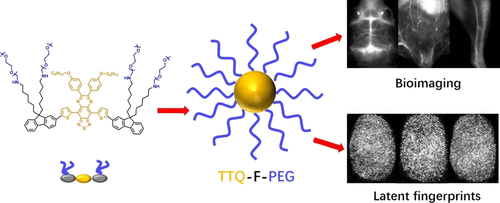当前位置:
X-MOL 学术
›
ACS Appl. Polym. Mater.
›
论文详情
Our official English website, www.x-mol.net, welcomes your
feedback! (Note: you will need to create a separate account there.)
Water-Soluble Donor–Acceptor–Donor-Based Fluorophore for High-Resolution NIR-II Fluorescence Imaging Applications
ACS Applied Polymer Materials ( IF 4.4 ) Pub Date : 2021-05-28 , DOI: 10.1021/acsapm.1c00456 Kun He 1 , Shangyu Chen 1 , Yan Chen 1 , Jiewei Li 2 , Pengfei Sun 1 , Xiaomei Lu 2 , Quli Fan 1 , Wei Huang 3
ACS Applied Polymer Materials ( IF 4.4 ) Pub Date : 2021-05-28 , DOI: 10.1021/acsapm.1c00456 Kun He 1 , Shangyu Chen 1 , Yan Chen 1 , Jiewei Li 2 , Pengfei Sun 1 , Xiaomei Lu 2 , Quli Fan 1 , Wei Huang 3
Affiliation

|
Understanding the mechanism of the donor–acceptor–donor (D-A-D) structure on fluorescence properties is very helpful for the design of small molecular NIR-II fluorophores. Based on this D-A-D scaffold, many electron-withdrawing or electron-donating groups and π-bridging moieties have been screened and used to adjust the highest occupied molecular orbital and lowest unoccupied molecular orbital levels to induce fluorescence emission into the NIR-II window. In this work, a series of D-A-D-type NIR-II fluorophores with acceptors of thienoisoindigo (TIIG) or 6,7-bis(4-(hexyloxy)phenyl)-4,9-di(thiophen-2-yl)-[1,2,5]thiadiazolo[3,4-g]quinoxaline (TTQ) as well as four typical electron donors of thiophene (T), triphenylamine (TPA), 9,9-dioctyl-9H-fluorene (F), or 2-(9,9-dioctyl-9H-fluoren-2-yl)thiophene (TF) were synthesized. Their electronic structures and optical properties were investigated via theoretical and experimental studies. It was found that both acceptors and donors significantly influence the fluorescence properties, and TTQ-F exhibits the strongest fluorescence intensity and highest quantum yield. To achieve further NIR-II bioimaging applications, the TTQ-F with desirable NIR-II emission was further modified by PEG5k to improve its water solubility, and a PEGylated NIR-II polymer, TTQ-F-PEG, was obtained. The bright fluorescence image, good photostability, and large penetration depths of TTQ-F-PEG enabled it to be applied in bioimaging with high resolution and imaging quality. The in vivo NIR-II imaging of vasculature, lymph node, vascular hemorrhage, and gastrointestinal tract in mice was extremely clear. As another application example, TTQ-F-PEG also significantly improved the enhancement of latent fingerprints with good definition and stability.
中文翻译:

用于高分辨率 NIR-II 荧光成像应用的水溶性供体-受体-供体荧光团
了解供体-受体-供体 (DAD) 结构对荧光特性的作用机制对于小分子 NIR-II 荧光团的设计非常有帮助。基于这种 DAD 支架,许多吸电子或给电子基团和 π 桥接部分被筛选出来,用于调整最高占据分子轨道和最低未占据分子轨道水平,以诱导荧光发射到 NIR-II 窗口。在这项工作中,一系列 DAD 型 NIR-II 荧光团具有噻吩异靛蓝 (TIIG) 或 6,7-双(4-(己氧基)苯基)-4,9-二(噻吩-2-基)-[ 1,2,5]噻二唑并[3,4- g ]喹喔啉 (TTQ) 以及噻吩 (T)、三苯胺 (TPA)、9,9-二辛基-9 H 的四种典型电子给体合成了-芴(F)或2-(9,9-二辛基-9H-芴-2-基)噻吩(TF)。通过理论和实验研究研究了它们的电子结构和光学性质。结果表明,受体和供体均显着影响荧光特性,TTQ-F表现出最强的荧光强度和最高的量子产率。为了实现进一步的 NIR-II 生物成像应用,具有理想 NIR-II 发射的 TTQ-F 被 PEG 5k进一步修饰为了提高其水溶性,获得了聚乙二醇化的 NIR-II 聚合物 TTQ-F-PEG。TTQ-F-PEG具有明亮的荧光图像、良好的光稳定性和大的穿透深度,使其能够以高分辨率和成像质量应用于生物成像。小鼠血管系统、淋巴结、血管出血和胃肠道的体内 NIR-II 成像非常清晰。作为另一个应用实例,TTQ-F-PEG 还显着改善了潜在指纹的增强,具有良好的清晰度和稳定性。
更新日期:2021-06-11
中文翻译:

用于高分辨率 NIR-II 荧光成像应用的水溶性供体-受体-供体荧光团
了解供体-受体-供体 (DAD) 结构对荧光特性的作用机制对于小分子 NIR-II 荧光团的设计非常有帮助。基于这种 DAD 支架,许多吸电子或给电子基团和 π 桥接部分被筛选出来,用于调整最高占据分子轨道和最低未占据分子轨道水平,以诱导荧光发射到 NIR-II 窗口。在这项工作中,一系列 DAD 型 NIR-II 荧光团具有噻吩异靛蓝 (TIIG) 或 6,7-双(4-(己氧基)苯基)-4,9-二(噻吩-2-基)-[ 1,2,5]噻二唑并[3,4- g ]喹喔啉 (TTQ) 以及噻吩 (T)、三苯胺 (TPA)、9,9-二辛基-9 H 的四种典型电子给体合成了-芴(F)或2-(9,9-二辛基-9H-芴-2-基)噻吩(TF)。通过理论和实验研究研究了它们的电子结构和光学性质。结果表明,受体和供体均显着影响荧光特性,TTQ-F表现出最强的荧光强度和最高的量子产率。为了实现进一步的 NIR-II 生物成像应用,具有理想 NIR-II 发射的 TTQ-F 被 PEG 5k进一步修饰为了提高其水溶性,获得了聚乙二醇化的 NIR-II 聚合物 TTQ-F-PEG。TTQ-F-PEG具有明亮的荧光图像、良好的光稳定性和大的穿透深度,使其能够以高分辨率和成像质量应用于生物成像。小鼠血管系统、淋巴结、血管出血和胃肠道的体内 NIR-II 成像非常清晰。作为另一个应用实例,TTQ-F-PEG 还显着改善了潜在指纹的增强,具有良好的清晰度和稳定性。































 京公网安备 11010802027423号
京公网安备 11010802027423号